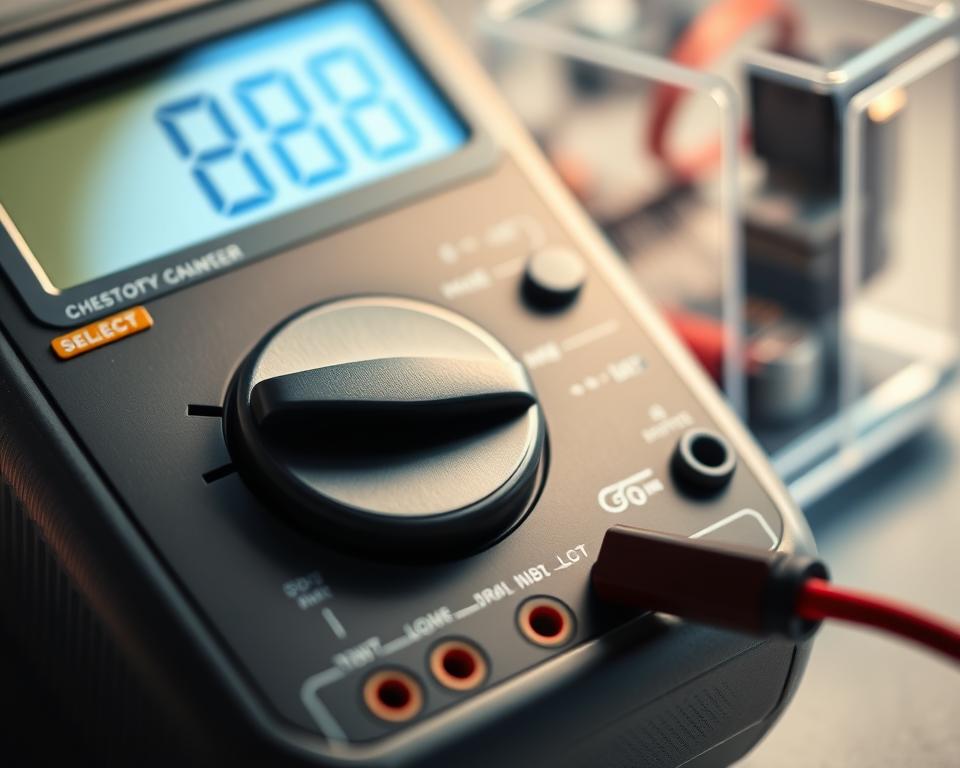Multimeter Employments: Crucial Capabilities Outlined
The typical multimeter can measure up to 20V in voltage levels. Yet numerous projects, notably in innovation and tech circuits, utilize less than 200mA of current. This reality emphasizes the vital role multimeters play in circuit analysis and problem resolution. Knowing how to operate a multimeter is imperative, not just for practitioners and specialists, but also for pupils examining circuit theories.
Multimeters are irreplaceable in their flexibility, offering precise measurements of electrical potential, current, and resistance. This article will investigate the various roles and functions of a Cen Tech 7 function digital multimeter. It intends to furnish you with the insight to effectively use this critical tool in your electronic trials and initiatives.
Primary Points
- Multimeters are key tools for measuring electrical potential, current, and resistance.
- Understanding multimeter functions is crucial for efficient troubleshooting.
- Digital multimeters are popular for their lucidity and precision in readings.
- Safety precautions are imperative when operating a multimeter for electrical testing.
- Continuity assessment is an vital feature for verifying wiring integrity.
- Selecting the suitable multimeter can substantially affect your diagnostic productivity.
Introduction to Multimeters
A multimeter is vital for diagnosing electrical problems and ensuring devices operate correctly. It measures multiple electrical parameters, indispensable for both specialists and DIYers.
What is a Multimeter?
A multimeter integrates devices to measure electrical potential, current, and resistance. This aids substantially in addressing electronic faults. Available in traditional and digital models, multimeters are vital. Analog models use a pointer and dial for measurement, whereas digital ones show values on a screen. They evaluate wall outlets, batteries, and various gadgets.
Significance of Multimeter in Electrical Testing
In electronic evaluations, the role of a multimeter is paramount. It checks circuit integrity and detects issues in various environments. For example, in the car industry, it examines battery voltage and sensors. It also confirms industrial machinery functions seamlessly, preventing costly breakdowns.
Multimeters, essential for testing, measure AC and DC voltage, current, and resistance. Their capacity to manage varied tasks makes them invaluable for both basic and advanced projects.
Types of Multimeters
Understanding the multiple types of multimeters is essential for efficient electrical testing. They are divided into two primary classes: analog and digital multimeters. Each provides unique features and benefits. Therefore, choosing the right type depends on your particular demands and inclinations.
Analog Multimeters
Analog multimeters include a dial indicator and analog dial. They are ideal for tracking rapidly shifting values. Their design allows users to witness fluctuations as they occur. Analog devices offer a sensitivity range typically between 1K to 50,000 Ω/V, with the peak sensitivity reaching 20,000 ohms per volt. This rendered them popular for broadcast engineers in the mid-century period.

Digital Multimeters
Due to their exactness and performance, digital multimeters have turned into highly favored. Their LCDs exhibit measurements unambiguously and can reveal up to four digits. They can assess diverse attributes like voltage and heat level. Furthermore, high-end models offer automatic ranging, data logging, and wireless capabilities. This positions them as ideal for complex applications in fields like vehicle analysis and green power.
Contrast of Traditional and Electronic Multimeters
Choosing between traditional and electronic multimeters relies on your specific demands and price range. The table below outlines their primary distinctions:
| Feature | Traditional Multimeters | Electronic Multimeters |
|---|---|---|
| Visual Output | Dial needle on scale | Numeric display (LCD) |
| Measurement Accuracy | Good, but not as exact | Superior accuracy and detail |
| Reaction Time | Rapid response to changes | Depends on sampling rate |
| Applications | Optimal for quickly varying values | Versatile, used across diverse fields |
| Cost | Usually more affordable | Ranges significantly, but can be higher |
Although both multimeter types are essential for electrical testing, digital multimeters’ exactness and capability have made them more popular among users in both consumer and industrial spaces.
Components of a Multimeter
Grasping the key elements of a multimeter is crucial for its efficient use. It includes several primary components, each with a distinct role. The screen delivers measurements, while the function selector allows users to switch between functions like voltage, current, and resistance. Probes attach the device to the circuit being examined, serving as another vital feature.
Essential Components and Their Functions
The essential parts of a multimeter are categorized as:
- Visual Interface: Presents readings in live for straightforward comprehension.
- Function Selector: Allows users to select the setting, including voltage, current, or resistance functions.
- Connectors: Usually three, but some models have four for linking multiple probes.
- Measurement Leads: Critical for connecting the multimeter to electric circuits, with the red probe for positive and black for ground connections.
Comprehending Multimeter Probes
Probes play a fundamental role in multimeter operation. They are offered in multiple types, such as standard or alligator clips. The red probe is designated for testing electrical potential or resistance; the black functions as a ground. Using alligator clips simplifies tasks with multiple components, enhancing measurement accuracy and effectiveness.
How the Selection Knob Works
The selection knob is key for maneuvering through the device’s features. By rotating the knob, users can switch between AC and DC voltage measurements, current monitoring, or resistance testing. Choosing the appropriate setting is critical for precise readings. Users must be careful with the range setting to prevent device damage or erroneous readings.
Operations of a Multimeter
For anyone involved in electrical testing, familiarity with the multimeter’s capabilities is essential. These devices offer essential assessments for precisely assessing electrical components. They gauge voltage, assess current, and inspect resistance, making them vital for both expert usage and DIY projects.
Gauging AC and DC Voltage
Measuring both AC and DC voltage is a primary function of multimeters. They deliver remarkable exactness, with the ability to notice minor changes. This is vital for ensuring that electrical devices operate safely within their designated potentials.
Testing Current Measurement
Current measurement is more complex than voltage. You must break the circuit path where you want to measure, as the multimeter integrates into the circuit in series. Choose the proper range, marked in amps or milliamps. Securely connect the multimeter probes between the break points of the circuit.
Comprehending Resistance Measurement
Testing component functionality, like resistors and capacitors, is performed via resistance measurement. Multimeters can measure resistance up to multiple megaohms, which is crucial for assessing circuit integrity and conducting continuity tests.
Continuity Testing Capabilities
Continuity testing is essential for troubleshooting. It utilizes sound alerts or light indicators to signal electrical connections. This guarantees that circuits function as intended, aiding in efficient troubleshooting.
| Capability | Analog Multimeters | Digital Multimeters |
|---|---|---|
| Voltage Measurement | Measures AC and DC voltage with remarkable exactness | Evaluating energy source in devices |
| Current Measurement | Assesses circuit current in circuits | Checking battery voltage and sensor performance |
| Resistance Measurement | Tests the operation of circuit components | Ensuring resistors and diodes are within tolerance levels |
| Continuity Testing | Assesses electrical connections | Assessing circuit integrity |
Employing a Multimeter Safely and Properly
Comprehending how to operate a multimeter is essential for anyone working with electrical systems. Proper procedures secure security and precise readings. When gauging voltage, current, or resistance, each step requires particular safeguards.
Fundamental Safety Guidelines
Acquiring safety guidelines before using a multimeter is essential. Your multimeter should be certified for your job setting. Sadly, over a significant portion of electricians use inadequately rated tools, risking danger. To work securely, always verify the multimeter is accurately adjusted before attaching probes.
Steps for Measuring Voltage
Measuring voltage demands careful precision. First, determine the appropriate multimeter range for the voltage, AC or DC. Insert the probes into the designated ports: the common and voltage-specific ones. Then, connect the probes accurately to the circuit.
Procedure for Assessing Current
Current measurement is more intricate than voltage. You must disrupt the circuit path where you want to assess, as the multimeter is connected in series. Choose the appropriate range, marked in amperes or milliamps. Securely connect the multimeter probes between the break points of the circuit.
How to Test Resistance
To correctly assess resistance, remove the component in question. Switch the multimeter to resistance mode, then connect the probes to the component. A matching reading indicates that the component is in good condition; otherwise, it might be faulty. This measure prevents multimeter damage and ensures accurate electrical flow analysis.
Typical Uses of Multimeters
Multimeters are essential in both industrial and residential environments for a variety of functions. They shine in analyzing electrical circuits, rendering them priceless. These devices are crucial in identifying and correcting electrical problems, guaranteeing systems operate correctly.
Resolving Electrical Issues
Multimeters primarily are used to detect electrical circuit issues. Technicians and DIY enthusiasts use them to pinpoint problems. By assessing voltage, current, and resistance, they detect faulty parts, guaranteeing proper operation.
Testing Batteries and Energy Supplies
Evaluating batteries is a crucial application for multimeters. They assess voltage to assess automotive or household battery state of charge. This enables users to determine if a battery is functioning properly or is failing, enhancing energy management.
Verifying Circuit Integrity
For optimal operation, verifying circuit integrity is key. Multimeters evaluate this by examining continuity and resistance. They detect issues such as broken wires or defects, leading to timely fixes. Overall, multimeters enhance both the safety of installations and diagnostic processes.
Selecting the Appropriate Multimeter for Your Demands
Selecting the suitable multimeter improves your effectiveness in electrical testing. Key factors to consider include accuracy, testing capabilities, portability, and ease of use. Unlike analog meters, digital multimeters shine in functionality, preferred by technicians and hobbyists.
Key Considerations
Essential factors in choosing a multimeter include:
- Precision: Digital multimeters deliver high precision, capable of registering 1 millivolt.
- Measurement Ranges: Select models that support multiple electrical metrics like voltage, current, and resistance.
- Portability: Opt for compact, convenient designs for portable use.
- Usability: Automatic range selection and backlit displays make for a better user experience.
Top Picks: Cen-Tech 7 Function Digital Multimeter
The Cen-Tech 7 Function Digital Multimeter is renowned for its versatility and cost-effectiveness. It integrates key features appealing to both newcomers and professionals. Additionally, its automatic ranging feature streamlines measurements, enhancing task execution.
This model’s count capacity extends to 20,000, delivering exact results for a variety of electrical jobs. It performs exceptionally in troubleshooting, automotive tests, and battery checks. Its mix of essential features and simplicity of use makes the Cen-Tech 7 Function Digital Multimeter a preferred option for a new investment.
To Summarize
Grasping multimeter operations is key for those participating in electrical tasks. We’ve outlined multimeter functions, emphasizing their value in testing and safety. Their exactness in measuring voltage, current, and resistance is invaluable. Thus, multimeters are essential for both experts and DIYers.
Multimeters surpass mere measurements. They offer advanced capabilities like recording data and wireless connections. These features facilitate wide-ranging functions, from car diagnostics to exploiting renewable energy. Additionally, capabilities for continuity and frequency checks help pinpoint defects, ensuring systems run smoothly.
Armed with this insight, individuals can effectively utilize their multimeter proficiency for accurate fault detection and boosting protection. They can also boost the efficiency of electrical setups and maintenance. Essentially, multimeters’ adaptability renders them irreplaceable in achieving meticulousness in electrical jobs.
Frequently Asked Questions
Which main functions does a multimeter serve?
A multimeter primarily measures voltage (AC and DC), current, and resistance. It also conducts continuity tests. These capabilities are essential for identifying circuit issues and checking circuit health.
What factors determine whether to select an analog or digital multimeter?
Choosing between analog and digital multimeters is based on your preferences. Analog types are great for showing quick variations. In contrast, digital models provide precise numeric readings. This establishes their preference for daily tasks.
How can I ensure safety while using a multimeter?
When using a multimeter, always select the correct setting before connecting. Do not contact live circuits when assessing current. Also, remove components before resistance tests to prevent inaccurate readings.
Is it possible for a multimeter to evaluate batteries?
Yes, battery testing is a common use for multimeters. They gauge voltage to display charge level. This ensures that your power sources are trustworthy for various needs.
What is continuity testing, and why is it important?
Continuity testing checks electrical connections in a circuit using a multimeter. It’s essential for identifying and repairing discontinuities. This ensures that your electrical setups function properly.
What are the typical components found in a multimeter?
A multimeter typically comprises a measurement screen, a mode dial, probe ports, and the probes. The probes interface with the circuit being analyzed.
How does the Cen-Tech 7 Function Digital Multimeter compare to other models?
The Cen-Tech 7 Function Digital Multimeter is user-friendly and provides a range of capabilities, including auto-ranging. It’s economically priced, making it a good choice for experts and hobbyists.

